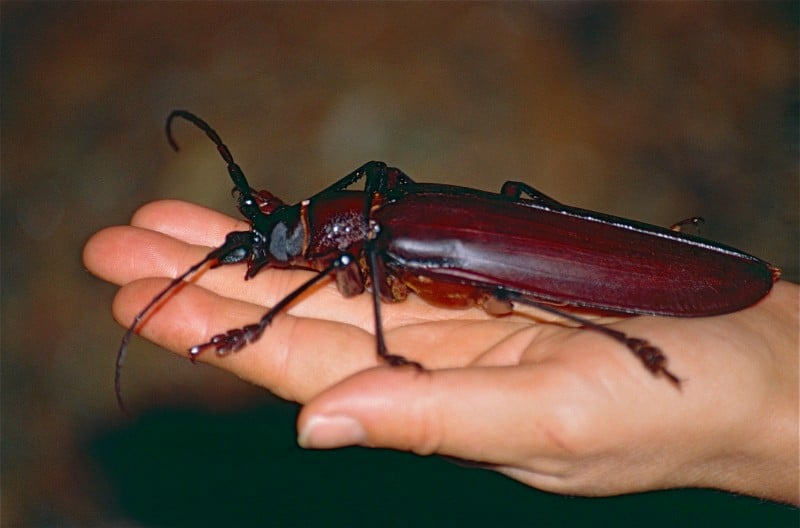
Titan Beetle Facts
- First of all, the astonishing Titan Beetle truly lives up to its common name. That holds true due to the fact that it ranks as the largest known variety of beetle on earth. Though many people believe it resembles a large cockroach, the invertebrate nevertheless remains a true beetle.
- Furthermore, this amazing invertebrate also has a rather mysterious side to it, as well. That’s because, despite years of effort by countless researchers, its life cycle remains undetermined. The reason for that ongoing mystery is that no larvae for it have ever been found.
- The creature also remains extremely strong for its size. Therefore, researchers must practice great caution when handling it. While not overtly aggressive by nature, its powerful mandibles can snap pencils. These can even pierce human flesh rather painfully.
- Additionally, as generally holds true for many tropical species, this remarkable and mysterious creature now faces serious danger. The Titan Beetle faces several dangers, including the threats of habitat loss and deforestation. But its greatest comes from climate change.
Related Articles
Goliath Beetle Atlas Beetle Tansy Beetle
Titan Beetle Physical Description
The adult Titan Beetle attains a truly enormous size for an insect. That’s because its body length reaches as much as 6.5 in (16.7 cm). In fact, only the Hercules Beetle attains a greater length. However, much of the length of that animal is comprised of its large horn. It also shows no noticeable sign of sexual dimorphism.
In addition, multiple boreholes found under fallen trees suggest, however, that the larva may attain even greater sizes than the adults. Based on uncovered evidence, researchers estimate that these unseen larvae may reach lengths of as much as 12 in (30 cm).
The majority of individuals typically present a color pattern mainly consisting of various shades of a dark, reddish-brown. However, certain small sections of its body and antennae often display an extremely dark brown, almost to the point of appearing as black.
Meanwhile, the short, curved mandibles of the Titan Beetle develop into extremely powerful tools and weapons. Furthermore, in the native environment of the insect, this aids both in self-defense and its feeding. It also develops sharp spines on each of its multi-jointed legs.
- Kingdom: Animalia
- Phylum: Arthropoda
- Class: Insecta
- Order: Coleoptera
- Family: Cerambycidae
- Genus: Titanus
- Species: T. giganteus
Photographer: Bernard DUPONT
CC License: https://bit.ly/1jxQJMa
Titan Beetle Distribution, Habitat, and Ecology
The truly amazing Titan Beetle, representing the only species in the genus Titanus, has a highly specific habitat type and range. That holds true because this enormous insect also appears to only be endemic to areas of tropical rainforest in certain portions of South America.
Entomologists believe that the larvae stay underground and feed on decaying wood. Evidence indicates this period may last for years. But, once it reaches adulthood and emerges, the adults emerge, mate, and live for only a few weeks. Further, during this time the adults do not feed at all.
This impressive insect also appears to be extremely reclusive.and pacifistic in nature. However, it remains capable of inflicting a dangerous bite if handled. Defensive strategies include biting with the powerful jaws. Most commonly, this action is also preceded by loud hissing noises.
Perhaps most surprising of all is the fact that, despite its rather great size, it still remains capable of short flights. But, due to the energy required, it rarely does so. Finally, while it lives, the adult form of the beetle remains entirely nocturnal in nature.
Species Sharing Its Range
Hoatzin Jabuticaba Bald Uakari
Check out our other articles on Earth’s Extremely Threatened Flowers, California Sea Lion, Reynisfjara Beach, Longnose Sawshark, Mountain Chicken, Picasso Bug, Puffin

